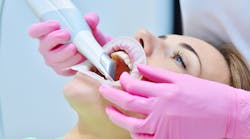A review of 4 intraoral scanners: Which is the right one for your practice?
In dentistry, making a perfect impression is one of the most important tasks. The conventional method is not always accurate and can be time-consuming, messy, and unpleasant for patients. Digital intraoral scanners do away with these issues.
Unlike the previously used technique, these devices are safe to use, reduce patient discomfort, help achieve the task faster, and produce accurate impressions, allowing dentists to provide efficient and accurate treatments. The images produced by the scanners can be used for diagnostics, orthodontics, and other removable appliances (e.g., nightguards and surgical templates) as well as for fabricating a whole series of dental prostheses, such as crowns, dentures, partial dentures, inlays/onlays, bridges, and implant-supported restorations. Since its inception, intraoral scanner technology has improved dramatically and has gained acceptance by practicing dentists and dental laboratories.
Save time and money with the right digital impressions and oral appliances
Dr. Pam's Practice Picks: Tech to impress new dental associates
With the geriatric population growing across the globe, the prevalence of dental disorders such as edentulism or tooth loss/decay is also increasing. This is a major factor that catalyzes the growth of the intraoral scanner market. Moreover, the development of new scanning technologies that allow easy portability and easy grasp ability for free movement in all directions inside the mouth is expected to offer a lucrative opportunity for market growth.
According to the research firm Allied Market Research, the global intraoral scanners market is anticipated to accrue a sum of $875.60 million by 2030, thereby exhibiting a compound annual growth rate (CAGR) of 18.6% during the forecast period, 2021-2030.1 The outbreak of the COVID-19 pandemic also positively impacted the growth of the intraoral scanner market, as some patients encouraged the use of digital intraoral scanners instead of conventional techniques, which raised the demand for CAD/CAM and 3D printing. Dental treatment cost is likely to rise in the coming years due to soaring demand for more effective and affordable digital dentistry equipment, which is likely to offer growth opportunities for the intraoral scanners industry.
Various intraoral scanners have been introduced in recent years, and more and more dental clinics have started adopting these devices for taking digital impressions. Key companies in the market are introducing innovative products that cater to the needs of dentists:
3Shape, a Denmark-based developer and manufacturer of 3D scanners and CAD/CAM software for the dental industry, recently unveiled its Trios 5 Wireless, a state-of-the-art, compact, hygienically optimized intraoral scanner that allows dentists to perform effortless scanning.
Neoss Group, a provider of intelligent and easy-to-use solutions for dental professionals, launched a new intraoral scanner called NeoScan 1000 at the company’s Neoss Integrate 2022 in Gothenburg, Sweden.
DOF Inc., a CAD/CAM solution company specializing in developing 3D dental scanners and dental milling machines, introduced its intraoral scanner Freedom HD at Lab Day Chicago, the largest international gathering of the dental laboratory community in North America.
Glidewell Dental, one of the largest dental labs in the world, collaborated with Medit, a provider of 3D measurement and CAD/CAM solutions for dental clinics and labs, to launch the fastscan.io intraoral scanner, an ideal tool for dentists who seek to simplify treatments, optimize results, and enhance the lives of patients.
3Shape unveils new intraoral scanner
Launched in September 2022, the Trios 5 Wireless intraoral scanner weighs just 10.6 ounces and is 10.5 inches long. The sleek technology can be easily held by hand and enables smooth and easy scanning. Moreover, as the scanner is portable, it can be taken anywhere using Trios Share to scan from every PC in the dentist’s practice. Featuring ScanAssist intelligent alignment technology, a built-in LED ring, and haptic sensory feedback, the scanner provides the highest standard in imaging performance and infection control. The LED ring and sensory feedback allow dental professionals to take digital impressions quickly and smoothly. The ScanAssist engine reduces incorrect arrangement and deformation in 3D models and enables clinicians to scan patients in any desired direction. Trios 5 also comes with a scanner tip covered by a scratch-resistant sapphire glass and sleek sleeves to make it hygiene-friendly.
Neoss showcases intraoral scanner
NeoScan 1000 compact and lightweight intraoral scanner became a favorite among testers of the technology due to its flexible workflow with open files and ability to produce impressions that are easily shareable among dental professionals. The NeoScan comes with an ergonomically designed handle and offers a high-definition field-of-view. The true-color image of impressions that the scanner produces makes it easier for dentists to distinguish tooth structure from soft tissues. Additionally, the motion-capture feature and buttons on the handpiece allow clinicians to carry out all the scanning, optimizing, and exporting tasks. The NeoScan also comes with features such as scan history management, smart reminders, margin line tools, inspection, and measurement.
DOF Inc. introduces Freedom i
The Freedom i intraoral scanner was designed to offer dentists several advantages. With an easy grip, the device can be connected in both wireless and wired modes. Freedom i is lightweight and runs with a commercial battery that can be purchased anywhere. It can scan the whole mouth and be controlled only with the mounted scan joystick, which eliminates the need for dentists to touch the mouse or screen while scanning a patient’s mouth. Hence, Freedom i enables extreme convenience while scanning, and it maintains hygiene. The scanner allows dentists to easily save and send scanned information to Sync, the company’s dental CAD/CAM platform. Sync is used by dental professionals to send scanned information to a laboratory or request designs from experts by using DOF Bridge, the company’s design platform.
Glidewell Dental inks deal with Medit
To help dental professionals ease out the process of treatment, optimize results, and enhance patient outcomes, Glidewell formed a partnership with Medit to launch the fastscan.io intraoral scanner. The deal helps Glidewell expand its product portfolio of digital solutions. Integrating the Medit i700 technology and a seamless connection to the glidewell.io in-office solution and Glidewell’s dental lab, the scanner is designed in a way that helps dentists easily send cases to Glidewell and save more on restorations. The new intraoral scanner offers the same speed and accuracy as that of the i700 and comes with reversible tips, a detachable cable, and an embedded UV-C LED disinfecting light to help minimize the risk of contamination. The fastscan.io can gain easy access to a suite of proprietary Medit software and apps, including Ortho Simulation, Model Builder, and Crown Fit, among others. According to Robert Brenneise, vice president of CAD/CAM sales at Glidewell, the company aims to develop user-friendly and cost-effective technologies that dental professionals can easily adopt. Collaborating with Medit allows Glidewell to focus on similar goals and improve the lives of dentists and their patients through digital innovations.
Editor’s note: 3Shape, Neoss, Glidewell, and Medit are among Dental Economics’ financial supporters.
This article appeared in the December 2022 print edition of Dental Economics magazine. Dentists in North America are eligible for a complimentary print subscription. Sign up here.
Reference
- Suraj S, Avinash G, Onkar S. Intraoral scanners market insight 2021-2030. Allied Market Research. April 2022. https://www.alliedmarketresearch.com/intraoral-scanners-market







